Damper tape for floor screed
The surface of the concrete mass of the screed during drying is covered with cracks. Sand-cement mixtures under the influence of heat expand in volume and press on the walls. The increase in the hardened surface of the floor in a room with an area of twenty square meters reaches 1 centimeter. To avoid swelling of the coating, to ensure uniform surface leveling and soften the pressure of concrete on the walls, builders use auxiliary cushioning elements. Initially, fragments of linoleum or wooden blocks were used as compensators. Highly effective materials, damping tapes, have been introduced into modern screed laying technologies.
The content of the article
- Purpose of damping tapes
- Buffer tapes: advantages of operation
- Additional functions of the compensation tape
- Flooring technology: video tutorial
- Sizes and types of damper tapes
- Types of compensation tapes
- How to replace
- We buy a damper tape: what to look for
- Prices and brands of manufacturers
- How to mount a damping tape for a coupler
- Installation of damper tape: video instruction
- Subtleties of installation work
- How to fasten edge strips
- What is used instead of buffer tapes
Purpose of damping tapes
Edge (compensation, damper, buffer, edge - other product names) tape is intended for laying in the gap between the screed floating type and wall. The material for the manufacture of the damper (buffer) is foamed polyethylene or styrene. Commodity form - stripes of elastic structure, rolled up into rolls. The functions of the edge tape are the division of the screed in the room of the spacious area into sections, the design of the floor with expansion joints. Buffer tapes use:
- for sound insulation;
- thermal insulation;
- equipment for underfloor heating.
The installation of the damper tape at the corners and walls around the perimeter prevents vibrations from the floating screed. The material reduces impact noise and retains heat at adjacent walls. The scope of the compensation tape includes the formation of waterproof concrete blind areas, foundations, rough bases for coatings.
Buffer tapes: advantages of operation
Damper tape for screed has significant operational advantages:
- retains heat, takes the desired shape, wrinkles and restores;
- prevents leakage of heat flows through the joints;
- fits easily and effortlessly;
- ecologically safe: rotting processes do not develop, fungus does not form, parasites do not start;
- provides waterproofing and soundproofing;
- not destroyed over time.
Additional functions of the compensation tape
Edge tapes are used in additional work on the device of the floor. Builders lay a barrier of tape from the spreading of the solution, divide the surface of a vast area.
An additional area of application of compensation tapes includes:
- plumbing work;
- exterior decoration of buildings - laying between the blind area and the wall;
- vapor barrier on the roofs.
Damper elements are used to wrap around pillars or columns.
When laying thin-layer screeds or leveling masses, edge tapes are not used.
Flooring technology: video tutorial
Sizes and types of damper tapes
Sealers are manufactured and sold in rolls. Length - from 10 to 50 meters, one hundred meter bobbins are also found. Typical material widths are 10 or 15 centimeters. The width is selected according to the design features and screed thickness.
Types of compensation tapes
Damper tape for floor screed represented by three types:
- Standard self-adhesive strips.The production uses polyethylene foam structure, styrene. Features - easy and quick parallel mounting to walls.
- Stripes with Basques (skirts). When laying the material in the gaps, part of the strip protrudes beyond the edge - 0.4–1 cm. Durable basques fit snugly against the floor along the walls and partially cover the floor coverings. The industry produces two types of tapes with basques: ordinary and on a self-adhesive layer. Features - ensuring tightness of corners.
- Self-adhesive backing strips. Before mounting, the protective paper element is removed, the tape is attached to the surface on the sticky side. Features - lack of product slip during screed pouring.
How to replace
To save money, some home craftsmen are looking for a replacement for factory dampers. The main varieties can be replaced with self-made (cut) tapes from soft elastic materials, foam strips, wooden battens in a polyethylene sheath. But these options have disadvantages: fragility, vulnerability to destructive factors, the complexity of installation.
We buy a damper tape: what to look for
When choosing a material, consider the following recommendations:
- Choose a tape suitable for the construction task type.
- Keep in mind that the width of the tape exceeds two to five centimeters of the height of the screed.
- Examine the product carefully, pay attention to the integrity of the structure.
- Do not buy if you see uneven surfaces, curves or torn edges, dents, holes or other defects. Improper storage of the tape in a roll leads to deformation and loss of performance.
- Consider the canvas and evaluate the appearance: surface cleanliness, absence of crevices, voids and crevices. Make sure that the sticky layer is not broken. Otherwise, the tape is unsuitable for fastening.
- Do not purchase discounted items.
- Choose models with trimming marking lines.
Prices and brands of manufacturers
The cost of a standard roll of a damper product depends on the brand, roll length, product width, quality level. The stores offer an assortment of popular brands Knauf, Energofleks, Teplofleks, Tilit-Super, Uponor, Leroy Merlin and other brands. The price range of products is wide: from 50 to 700 rubles per roll. Adhesive seals are more expensive.
Below is the price list of different manufacturers, taking into account the parameters of the tape.
How to mount a damping tape for a coupler
Determine the required size of the compensation tape, prepare a sufficient amount of material.
Laying procedure:
- Clean floors and walls of dust, remove construction debris from the surface.
- Treat surfaces with a degreasing agent to improve adhesion. Dry the surface.
- Lay the tape, cut off the excess edge parts (optional if skirting boards will be mounted).
- Cover the basques (skirts) with mortar, make sure there are no voids.
- Walk on the gasket with a roller to additionally press the material against the walls and eliminate small bumps.
- Fill the screed.
Installation of damper tape: video instruction
Subtleties of installation work
Despite the ease of installation of the damper tape, the installation process requires compliance with certain rules. Installation errors can cause damage to the flooring, failures of the underfloor heating system, and deformations of the baseboard.
- Lay polymeric strips of the foam structure at plus temperature conditions.
- Avoid frequent docking areas.
- Glue the entire perimeter of the equipped floor of the room, try not to leave gaps.
- Put skirts (basques) with a bend on the floor to avoid loose fit. This will prevent liquid dropping under the tape.
- Ensure proper storage of rolls - in a dry room with a temperature of 20-25 degrees.
Compliance with these rules will ensure high-quality flooring, high performance waterproofing and sound insulation, extend the life of the screed and coating.
How to fasten edge strips
The buffer tape is attached in several ways:
- on the sticky layer;
- furniture stapler;
- self-tapping screws;
- masking tape (temporarily);
- on the "liquid nails."
Stapler and metal staples are used in foam concrete houses. Hammers and tapping screws - a solution for brick houses. Holes are made with a puncher, into which screws are screwed. Masking tapes and PVA glue are temporary fasteners that are removed before pouring operations. The composition "liquid nails" is used for surfaces with irregularities.
What is used instead of buffer tapes
The factory product can be replaced with other materials: foil isol, penofol, isolon. Cut strips ten, twelve or fifteen centimeters wide (the size depends on how thick the screed is laid).
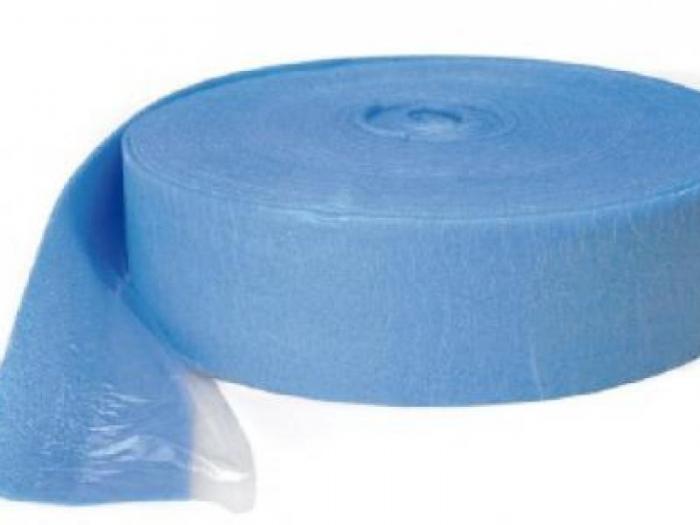

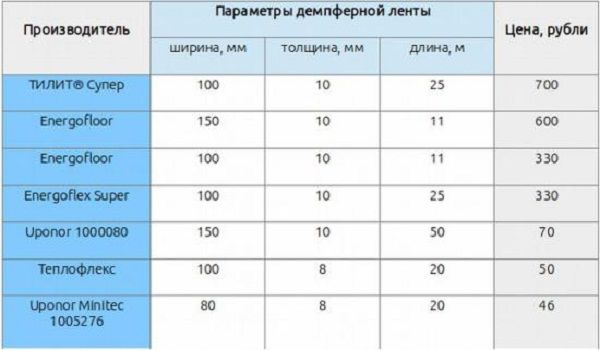
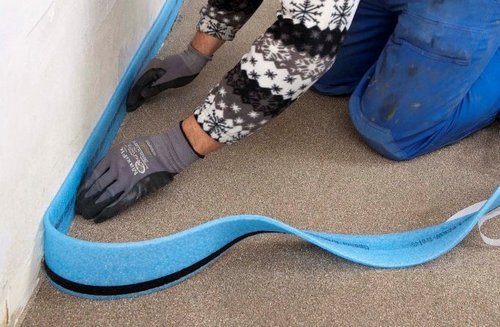
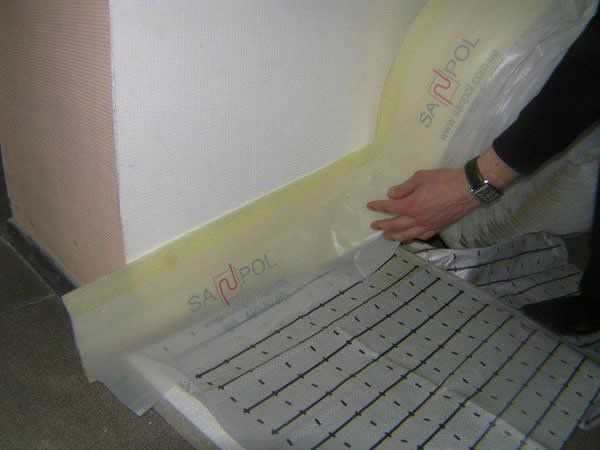


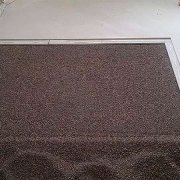
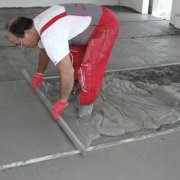
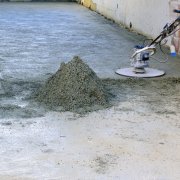
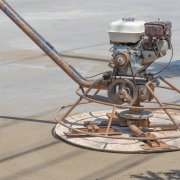
Tell me, is it worth using a tape for tiles in the bathroom?
I think not worth it!